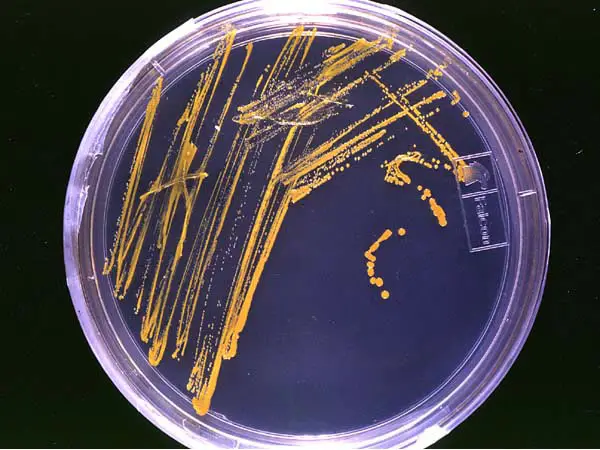Petri Dish with Agar
Preparation, Requirements and Procedure
A Petri dish (Petri plate) is a shallow cylindrical glass lidded dish that is typically used to culture microorganisms (agar plates). There are glass and plastic Petri dishes, and both can be sterilized (using an autoclave) and re-used. Before being used for culture purposes, it is important to ensure that the Petri dish is not only clean, but also sterile. This helps prevent the contamination of the new culture.
Agar is a polymer made up of various sub-units of galactose and various species of red algae. Although it has other uses including culinary and dentistry, agar plays an important role in microbiology as culture media for a variety of microorganisms.
As compared to some of the other alternatives like gelatin, agar has a number of advantages which include:
- Cannot be easily degraded by microorganisms
- Stronger
- Firmer than gelatin
Depending on the type or strain of bacteria being grown, there are different types of agar that may be recommended. Although great care has to be taken when handling any culture, plain nutrient agar, rather than an agar formulation that supports pathogenic bacteria is recommended for younger students or in the case of home experiments.
Common Types of Agar
- Chocolate agar
- Blood agar
- Macconkey agar
- Neomycin agar
- Nutrient agar
- XLD agar
** Note- students should always be supervised when handling agar
Preparation of Petri Dish with Agar
Before starting, ensure that the Petri dish (dishes) is closed/has its lid on until you are ready to pour the agar in to them.
Requirements
- Agar powder
- Lab thermometer
- Distilled water
- Glass stir rod
- Heat resistant hand protection
- Boiling mixture
- Sterile Petri dish
- Beaker/flask
Procedure
- Measure the recommended amount of agar and distilled water in to a clean, sterile flask or beaker
- Using heat resistant hand protection, hold the beaker/flask over a flame and stir the mixture gently using a sterile stir rod while heating
- Continue boiling the mixture for about one minute, and then remove from heat
- Place a sterile lab thermometer in the mixture and monitor until its temperature falls to about 47 degrees (45- 50 degrees)
- Pour melted agar in to the Petri dish to cover the bottom (about a quarter) and replace the lid immediately
- Allow the agar plate to cool and set (the medium will set like gelatin at room temperature)
- Ready for storage once it sets
During storage (in refrigerator, but not to freeze) the agar plates should be placed in an inverted position with the lid at the bottom. This prevents the condensation from dripping down on to the surface of the agar, which may allow for the movement of the organisms from one colony to another.
Although preparing agar plates may be a fun activity, ready to use agar plates are available in various (trusted) laboratory stores. This is mostly recommended for home use for those who may not wish to go through the process of preparing the agar themselves.
Conclusion
Preparation of agar plates is an easy and fun exercise for both the students and teachers/parents. Agar powder or agar preparation kit will also come with instructions/procedure, which allows for a much easier and fun time during the preparation process.
Although it may prove easy and fun for many, it is always important to ensure that all the safety precautions are taken to avoid possible accidents and injuries. Moreover, enough care should be taken to avoid contaminating the plate, which would introduce other unwanted microorganisms in to the prepared agar plate.
For instance, closing the Petri dish before pouring the melted agar ensures that the Petri dish does not get contaminated. If stored properly, the plate is ready to be used to culture the intended microorganism.
Learn more about Cell Culture, Cell Division, Cell Differentiation and Cell Staining.
See the main page on Microorganisms
As well as Tissue Culture and Bacteria under the Microscope
Return to Beginner Microscope Experiments
Return to MicroscopeMaster home
Find out how to advertise on MicroscopeMaster!





